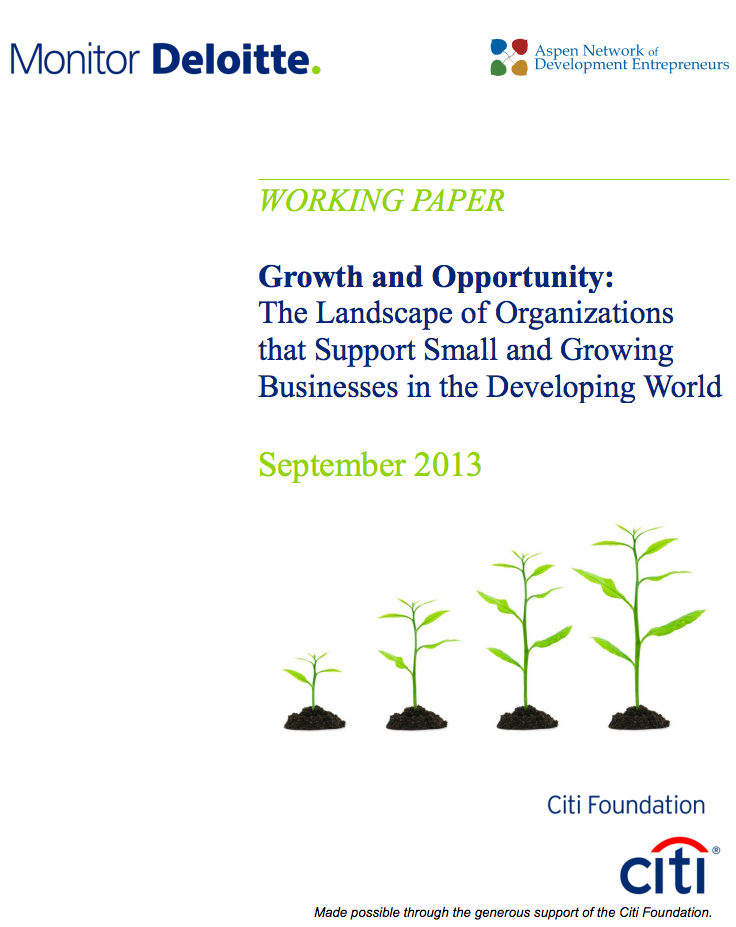Weekly Roundup – 11/22/13: Nudging the middle men and women of social enterprise
Why should we focus so much on small and growing businesses (SGBs) over, say, microenterprises when it comes to business solutions to poverty?
For one, companies with 10–50 employees generally offer wage premiums of 10-30 percent above that of micro-enterprises employing fewer than 10 workers. That wage premium jumps to 20-50 percent if the business has more than 50 employees, according to the IFC Jobs Study: Assessing Private Sector Contributions to Job Creation and Poverty Reduction.
For two … actually, I’m not sure we really need a second reason. The first seems sufficient, doesn’t it?
The IFC study is one of several cited in the recently released Growth and Opportunity: The Landscape of Organizations that Support Small and Growing Businesses in the Developing World, conducted by Monitor Deloitte and commissioned by the Aspen Network of Development Entrepreneurs (ANDE) with support from the Citi Foundation. Last year, ANDE reported 171 members operating in more than 150 countries, 32 member-managed funds investing about $229 million, and 40 capacity development providers giving $95 million in development services to more 13,000 SGBs. The association also included 14 foundation members that disbursed some $129 million into the SGB ecosystem.
This working paper doesn’t simply look at what small and growing businesses (those categorized seeking growth capital of between $20,000-$2 million) need to be doing, but what the “intermediaries” need to be doing to lift budding businesses.

Those intermediaries come in two classes: those directly engaging with SGBs by providing them capital or capacity development services, and those with indirect consequences that are working to improve the broader social enterprise sector. They range from giant development finance institutions and foundations, large enterprises and multinationals, capacity development providers such as business incubators and accelerators, and investors of all shapes and sizes.
Researchers interviewed about 60 people, including investors, capacity development providers, corporations, researchers, network leaders, and development finance institutions. In essence, this is the glue that holds together the small- and medium-sized business tier, especially those catering to socially inclined causes like fighting poverty. Providing this infrastructure is especially critical considering the attention impact investing is getting worldwide.
“It would be a shame to miss the opportunity presented by the impact investing movement because investors cannot find deals and reluctantly deploy their capital in other directions” the report notes. “Intermediaries are the entities best placed to help increase deal flow, in terms of both the number and scalability of enterprises.”
While the sector and the wrap-around intermediary services to support it continue to grow, the challenges are not abating so quickly. Here are just a few of those barriers to intermediaries, which will be familiar to almost everyone:
• Aligning the investment capital that has been raised with viable SGBs
• Securing funding for capacity development providers to help grow the supply of SGBs
• Measuring and communicating impact to funders and potential corporate partners, including banks
• Retaining top talent
• Adapting to varied local challenges, including regulatory environments
“ … the SGB sector — especially its intermediaries — has been too quiet and too careful about promising more than it can deliver. This sector needs to speak up and with a stronger, collective voice. It needs to organize the evidence for its impact, make the case to donors and partners, and attract new resources.”
The study offers several suggestions for how the intermediaries can speak with a megaphone and not a whisper. Check out the full report here.
In Case You Missed It … This Week on NextBillion
NextThought Monday: Opening the Curtain on the New 2.0 Era of Impact Investing By Ben Thornley
Mobile Health Targets Women: Yet many don’t have mobile phones By Ariel Gruver
The Power of Choices: Applying behavioral economics to financial services – part 1 of our interview with Alexandra Fiorillo, VP at ideas42 By James Militzer — WDI
The ABCs of Innovation and Prosperity for the Good of All (Part I) By Rochelle Beck — Ashoka
Debunking Myths About Products for Africa: Zyomyx develops test for HIV/AIDS treatment with service-free accessory By Karen Schlein
People-Centered Finance: How behavioral economics can improve financial products – part 2 of our Q&A with Alexandra Fiorillo, VP at ideas42 By James Militzer — WDI
If You Can Only Read One Book On Social Innovation … Ken Banks has made us that book By Cheryl Heller
A Really Big Tent: Danone trying to maximize its potential through inclusiveness By Kyle Poplin — WDI
